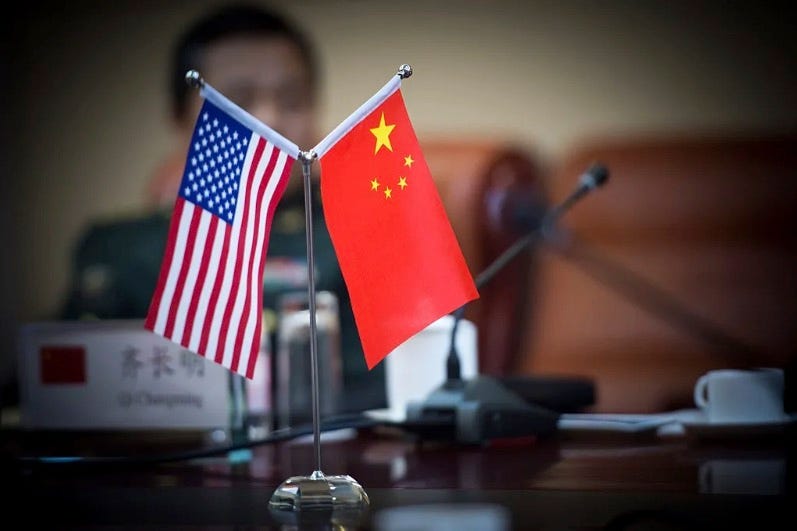China plays climate card as U.S. trade talk softens
Welcome to Callaway Climate Insights, your daily guide to global climate finance. Please enjoy, and share.
Today’s edition of Callaway Climate Insights is free for all our readers. We really want to bring you the best and latest in climate finance from around the world. Please subscribe now.
As President Donald Trump softened his tough tariff talk on China this week, cheering markets, China’s Xi Jinping leaned into climate change to fill the gap left open by a withdrawing U.S.
Xi spoke to international leaders from the EU, Brazil, the United Nations and others to reiterate China’s commitment to fighting climate change with renewable energy despite the current global uncertainty around Trump’s tariff plans.
China is a leader in the export of solar panels and minerals for batteries for electric vehicles and would be badly hit by the high tariffs threatened by the U.S. It also had ambitions to grow the exports of its own EV brands, particularly the popular BYD cars, in Europe and in South America.
By playing the climate card, Xi is seeking support from the rest of the world as he prepares for a confrontation with Trump on trade. It’s a high stakes game of geopolitical chess that includes Tesla and Elon Musk as pawns because of their business in China.
Charm offensives are always welcomed in leadership circles, but cautiously. No doubt the other leaders were encouraged to hear Xi’s remarks, especially with the UN’s big climate summit in Brazil coming up later this year.
But in the absence of resolution of the tariff issue with the White House, there’s not much else China can do.
Don’t forget to contact me directly if you have suggestions or ideas at dcallaway@callawayclimateinsights.com.
Follow us . . . .
Twitter | LinkedIn | Facebook | Instagram
Think the clean energy tax credits are safe? Think again
. . . . As Trump’s “big, beautiful” tax bill takes shape in Congress, one of the thorniest questions is how Republicans will pay for it, and former President Joe Biden’s climate-friendly Inflation Reduction Act is a prime target, writes Bill Sternberg. Despite the fact that many Republicans support Biden’s clean energy tax credits because they benefit their constituencies with jobs and investment, the politics of passing the tax bill will make voting against Trump a risky decision come crunch time. Most at risk, according to tax experts, appear to be the electric vehicle tax credits, followed by renewable energy subsidies.
Thursday’s subscriber insights

Dwindling Tesla bulls still respond to Musk’s bait
. . . . It was a unique market paradox this week that Tesla TSLA 0.00%↑ shareholders, who have been recently dumping their stock as fast as Cybertruck owners can drive to the second-hand dealership in protest of Musk’s dirty work at DOGE, would suddenly buy shares on the prospect that he’s coming back to the struggling EV leader.
Dwindling Tesla bulls just can’t seem to resist the bait that Musk will return to the company and revive its fortunes, including its controversial Robotaxi program. Tesla shares popped Tuesday night after Musk said he will greatly reduce his DOGE work next month, despite the fact that Tesla earnings collapsed 71% last quarter.
After all the chaos Musk has caused in Washington, is he really going to now save Tesla’s damaged brand by coming back?
No doubt the brand clearly needs some attention. Like all automakers, Tesla is suffering from uncertainty with Trump’s tariffs. Tesla’s neck and head are even further above the parapet as its close ties with China have made it a pawn in the increasingly bitter U.S.-China trade war.
But Tesla has another unique problem, which is that the magic has worn off the Musk mystique. The DOGE cuts, while supported by some, triggered intense protests against Musk in the form of customers selling their Tesla’s or buying from the competition. The brand was badly damaged.
Against this backdrop, we’re not sure that for Tesla, as it looks to be an uncertain second quarter and full year, more Musk is the answer.
Editor’s picks: Why it’s not too late to change; plus, slow progress in rebuilding LA fire areas
Watch the video: ABC’s Chief Climate Correspondent Ginger Zee shows us why it’s not too late to stop the worst impacts of climate change and how new innovations could be the key to slowing or even reversing the climate crisis.
Long road ahead for LA fire recovery
It’s been 100 days since the Los Angeles fires destroyed communities from Altadena to Pacific Palisades. The LAist reports that hundreds of lawsuits have been filed and millions of tons of debris are being removed. There has been some progress in recovery, but there’s a long way to go, the report says. The Environmental Protection Agency (EPA) has completed the first phase — removal of hazardous debris such as lithium batteries, paints and propane tanks — in the Eaton and Palisades burn areas. The U.S. Army Corps of Engineers and L.A. city and county will handle the second phase, removing the rest of the debris and some topsoil. As of April 18, just one rebuild permit has been issued in Altadena. In Pacific Palisades, 19 permits have been issued, officials told LAist. The report cites State Insurance Commissioner Ricardo Lara as saying last week that some 38,000 insurance claims have been filed, with more than 27,000 being partially paid. That adds up to more than $12 billion paid out so far.
Latest findings: New research, studies and projects
Cooling Earth by pulling carbon from the sky
Nature.com reports on efforts to pull more greenhouse gases from the air. In addition to direct air capture and reforestation projects, a new U.S. experiment, called LOC-NESS, is designed to test one strategy to remove CO₂ from the atmosphere. According to the report, U.S. scientists will add a solution of antacid to the ocean waters off the coast of Massachusetts. Using boats, buoys and gliders, the scientists will track changes in water chemistry that should allow the area to absorb more CO₂ from the sky than it normally would. Nature reports that “although the basic science behind this type of ocean experiment is sound, researchers aren’t sure how it will work in practice. The details matter, says Adam Subhas, a geochemist at the Woods Hole Oceanographic Institution in Massachusetts, who is heading up the four-year LOC-NESS project. ‘There’s all sorts of activity in the private sector,’ Subhas says, ‘and it’s really critical that the science keeps pace.’”
More of the latest research:
Climate Risk and Commercial Property Values: A Review and Analysis of the Literature
An Engineering Perspective on Climate Change: Mitigation or Adaptation?
Words to live by . . . .
“The world in which we live is collapsing and may be nearing the breaking point. Despite all attempts to deny, conceal, gloss over or relativize the issue, the signs of climate change are here and increasingly evident.” — Pope Francis.





